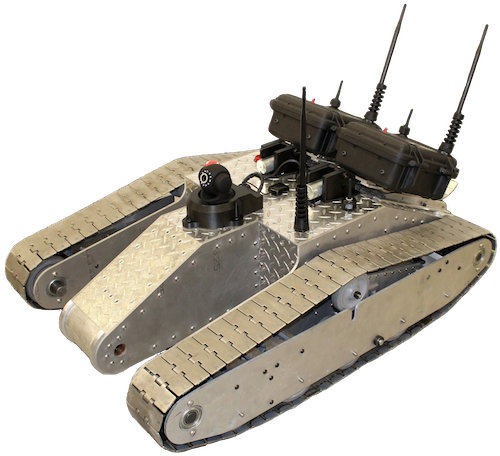Eight computer and electrical engineers built a WiFi Tank (Node.js robot) as part of a senior design project at Northeastern University, in Boston, Massachusetts. The robot brain is an EEE PC running Ubuntu, together with an Arduino board and is programmed using node.js. Each tank is equipped with a camera and 2 customized Wi-Fi repeaters (which it can drop it extend range), and it’s targeted at military operations or disaster-affected areas where network infrastructure is not available.
 Here are the key characteristics of this robot
Here are the key characteristics of this robot
- Robot controlled over WiFi
- 102 cm long, 71 cm wide, 41 cm tall, about 68 kg.
- Custom-built (except for treads) out of aluminum
- Range: 1 km with one on-board router and two droppable long-range repeater modules
- Running time: ~12 hours
- On-board webcam with microphone, night vision, pan and tilt
- On-board GPS for location tracking
- Custom-made remote user interface, works on any device with a web browser
- Built with an EEE PC running Ubuntu, Arduino, and Node.js
The EEE PC was installed inside the robot to control all hardware components, and the web interface looks just like the one would would get with an IP webcam, plus one part to control the tank and another to show the tank and repeaters position on the map using GPS.
 Here’s what you can do with this web interface:
Here’s what you can do with this web interface:
- Control the robot’s speed and direction using your keyboard’s arrow buttons or the web buttons
- View live webcam footage and control it (including pan/tilt, night vision, and audio)
- Drop WiFi repeater units to extend robot’s range
- View robot and repeater positions in real-time on a map using on-board GPS
- View repeater signal strengths in real-time
- View the status of the interface’s connection to the robot
- Begin replaying the robot’s movements backward if it loses its WiFi connection
- Run over lots of shit
So they installed an EEE PC running Ubuntu inside the tank and ran a node.js web server to handle the user interface and communicate with peripherals.
The developer (Glen Chiacchieri) explains that this robot is written almost exclusively using JavaScript. The source code is available on github,
Watch the video below to see some part of development and how the robot is actually used.

Further details are available on Glen Chiacchieri’s blog.

Jean-Luc started CNX Software in 2010 as a part-time endeavor, before quitting his job as a software engineering manager, and starting to write daily news, and reviews full time later in 2011.
Support CNX Software! Donate via cryptocurrencies, become a Patron on Patreon, or purchase goods on Amazon or Aliexpress




